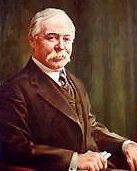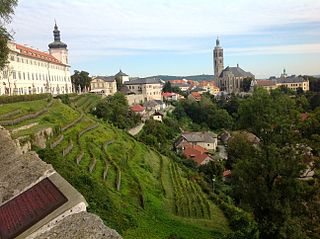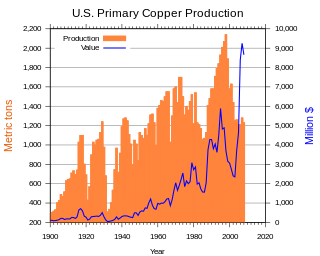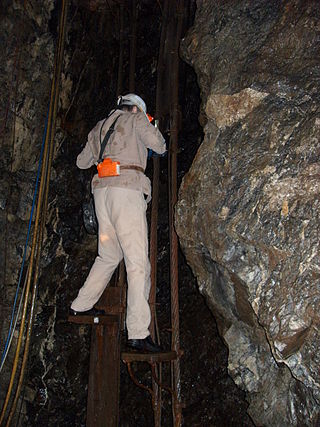

The Wenzel Pit (German : Grube Wenzel) is a former silver mine in the Zinken Frohnbach in Oberwolfach in the Black Forest in southern Germany. The pit had its heyday in the Napoleonic era, but has been a show mine since 2001.


The Wenzel Pit (German : Grube Wenzel) is a former silver mine in the Zinken Frohnbach in Oberwolfach in the Black Forest in southern Germany. The pit had its heyday in the Napoleonic era, but has been a show mine since 2001.
Silver has been mined here since the early 14th century; but after several decades they could find no more and the mine was closed. Not until about 1760 was silver found again in the mineshafts under the direction of the principality mining clerk (Bergschreiber), Kapf. This prospecting work discovered several silver deposits and mining recommenced.
After the founding of the Show Mines Friends Association (Förderverein Besucherbergwerke) in 1997 the old silver mine was restored in 1999 and developed for visitors. In 2001 the work was completed and the show mine was opened to the public.

The Black Forest is a large forested mountain range in the state of Baden-Württemberg in southwest Germany, bounded by the Rhine Valley to the west and south and close to the borders with France and Switzerland. It is the source of the Danube and Neckar rivers.

The Mesabi Iron Range is a mining district and mountain range in northeastern Minnesota following an elongate trend containing large deposits of iron ore. It is the largest of four major iron ranges in the region collectively known as the Iron Range of Minnesota. First described in 1866, it is the chief iron ore mining district in the United States. The district is located largely in Itasca and Saint Louis counties. It has been extensively worked since 1892, and has seen a transition from high-grade direct shipping ores through gravity concentrates to the current industry exclusively producing iron ore (taconite) pellets. Production has been dominantly controlled by vertically integrated steelmakers since 1901, and therefore is dictated largely by US ironmaking capacity and demand.

Marcus Daly was an Irish-born American businessman known as one of the four "Copper Kings" of Butte, Montana, United States.

Kutná Hora is a town in the Central Bohemian Region of the Czech Republic. It has about 22,000 inhabitants. The centre of Kutná Hora, including the Sedlec Abbey and its ossuary, was designated a UNESCO World Heritage Site in 1995 because of its outstanding architecture and its influence on subsequent architectural developments in other Central European city centres. Since 1961, the town centre is also protected by law as an urban monument reservation, the fourth largest in the country.

The Rammelsberg is a mountain, 635 metres (2,083 ft) high, on the northern edge of the Harz range, south of the historic town of Goslar in the North German state of Lower Saxony. The mountain is the location of an important silver, copper, and lead mine. When it closed in 1988, it had been the only mine still working continuously for over 1,000 years. Because of its long history of mining and testimony to the advancement and exchange of technology over many centuries, the visitor mine of Rammelsberg was inscribed as a UNESCO World Heritage Site in 1992.

Butte is a consolidated city-county and the county seat of Silver Bow County, Montana, United States. In 1977, the city and county governments consolidated to form the sole entity of Butte-Silver Bow. The city covers 718 square miles (1,860 km2), and, according to the 2020 census, has a population of 34,494, making it Montana's fifth-largest city. It is served by Bert Mooney Airport with airport code BTM.

The Berkeley Pit is a former open pit copper mine in the western United States, located in Butte, Montana. It is one mile (1.6 km) long by one-half mile (800 m) wide, with an approximate maximum depth of 1,780 feet (540 m). It is filled to a depth of about 900 feet (270 m) with water that is acidic, about the acidity of beer or tomatoes. As a result, the pit's water is laden with heavy metals and dissolved metals that leach from the rock in a natural process known as acid rock drainage. The dissolved metals include but are not limited to copper, arsenic, cadmium, zinc, and sulfuric acid.

The Oberwolfach Research Institute for Mathematics is a center for mathematical research in Oberwolfach, Germany. It was founded by mathematician Wilhelm Süss in 1944.

Parys Mountain is located south of the town of Amlwch in north east Anglesey, Wales. Originally known as Trysclwyn, the high ground is reputed to have gained its current name when it was given to Robert Parys, Chamberlain of North Wales by Henry IV. It is the site of a large copper mine that was extensively exploited in the late 18th century. Parys Mountain is a mountain in name only, being a hill with an elevation of less than 150m.

Big Muskie was a dragline excavator built by Bucyrus-Erie and owned by the Central Ohio Coal Company, weighing 13,500 short tons (12,200 t) and standing nearly 22 stories tall. It mined coal in the U.S. state of Ohio from 1969 to 1991. It was dismantled and sold for scrap in 1999.

Borken is a small town with about 13,000 inhabitants in the Schwalm-Eder district in northern Hesse, Germany.

In the United States, copper mining has been a major industry since the rise of the northern Michigan copper district in the 1840s. In 2017, the US produced 1.27 million metric tonnes of copper, worth $8 billion, making it the world's fourth largest copper producer, after Chile, China, and Peru. Copper was produced from 23 mines in the US. Top copper producing states in 2014 were Arizona, Utah, New Mexico, Nevada, and Montana. Minor production also came from Idaho and Missouri. As of 2014, the US had 45 million tonnes of known remaining reserves of copper, the fifth largest known copper reserves in the world, after Chile, Australia, Peru, and Mexico.

Altlay is an Ortsgemeinde – a municipality belonging to a Verbandsgemeinde, a kind of collective municipality – in the Cochem-Zell district in Rhineland-Palatinate, Germany. It belongs to the Verbandsgemeinde of Zell, whose seat is in the municipality of Zell an der Mosel.

SAG/SDAG Wismut was a uranium mining company in East Germany during the time of the Cold War. It produced a total of 230,400 tonnes of uranium between 1947 and 1990 and made East Germany the fourth largest producer of uranium ore in the world at the time. It was the largest single producer of uranium ore in the entire sphere of control of the USSR. In 1991 after German reunification it was transformed into the Wismut GmbH company, owned by the Federal Republic of Germany, which is now responsible for the restoration and environmental cleanup of the former mining and milling areas. The head office of SDAG Wismut / Wismut GmbH is in Chemnitz-Siegmar.

The Martha Mine is a gold mine in the New Zealand town of Waihi. Since July 2015 it has been owned by Australian-based OceanaGold.

The Samson Pit or Samson Mine is an historic silver mine in Sankt Andreasberg in the Upper Harz region of central Germany.

The Glasebach Pit is a mining museum and former pit in the Harz fluorspar mining area near Straßberg in the German state of Saxony-Anhalt. It is run by the East Harz Mining Society. The pit was founded under the name of Vertrau auf Gott.

The Carreau Wendel Museum is the museum of the Wendel-Vuillemin coal pit, in Petite-Rosselle on the Saarland, Lorraine border. Though often in Germany, since 1945 it has been in Moselle department France. The museum is an Anchor point on the European Route of Industrial Heritage.

The Clara Pit or Clara Mine is a working mine in Oberwolfach in the Black Forest in Germany in which the industrial minerals, baryte and fluorspar are mined.

MiMa is a museum of mineralogy and mathematics in Oberwolfach, in the central Black Forest in southern Germany. The museum was opened on 30 January 2010 on the site of the mineral museum after a two-year conversion and expansion phase. It is operated jointly by the municipality of Oberwolfach, the Oberwolfach Society of the Friends of Minerals and Mining and the Mathematics Research Institute, Oberwolfach.